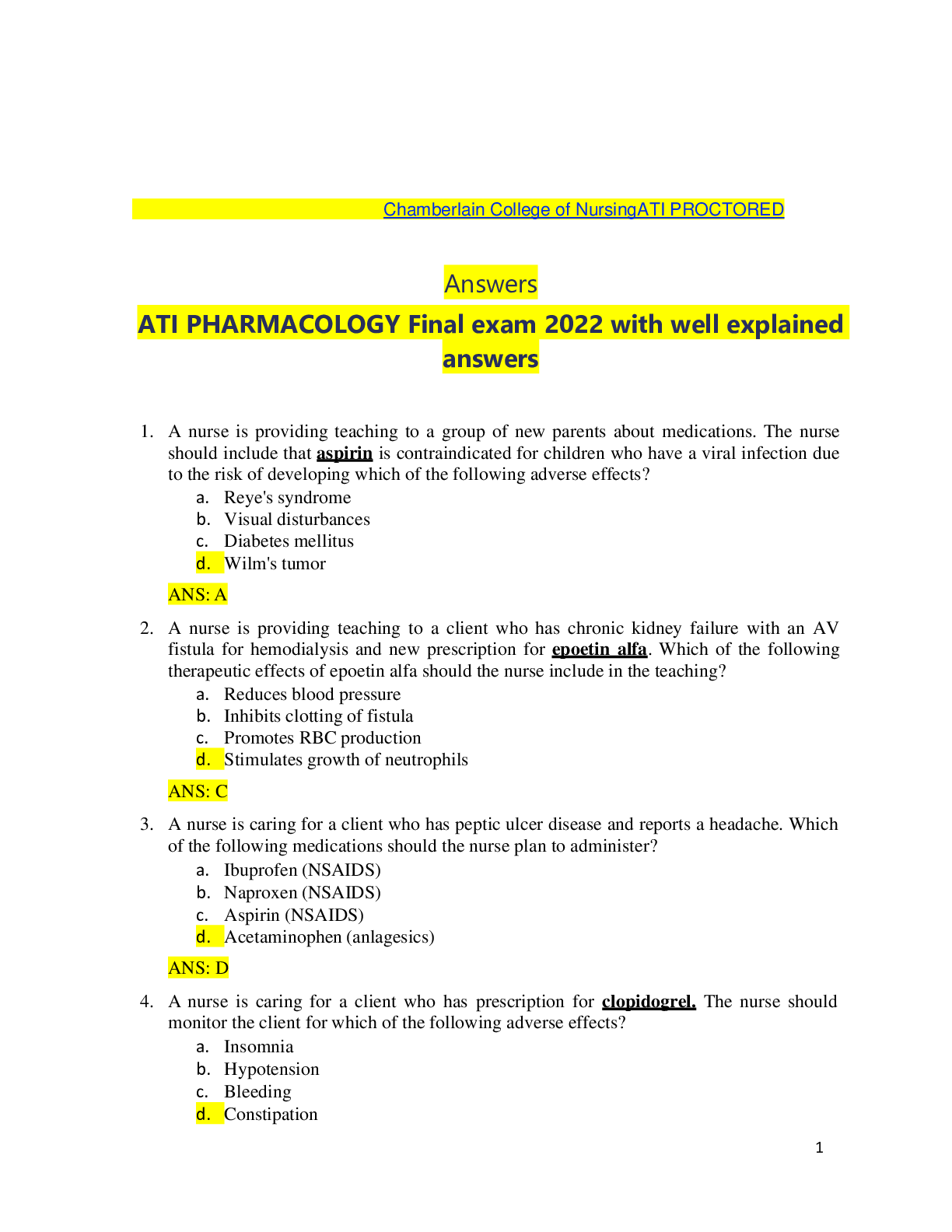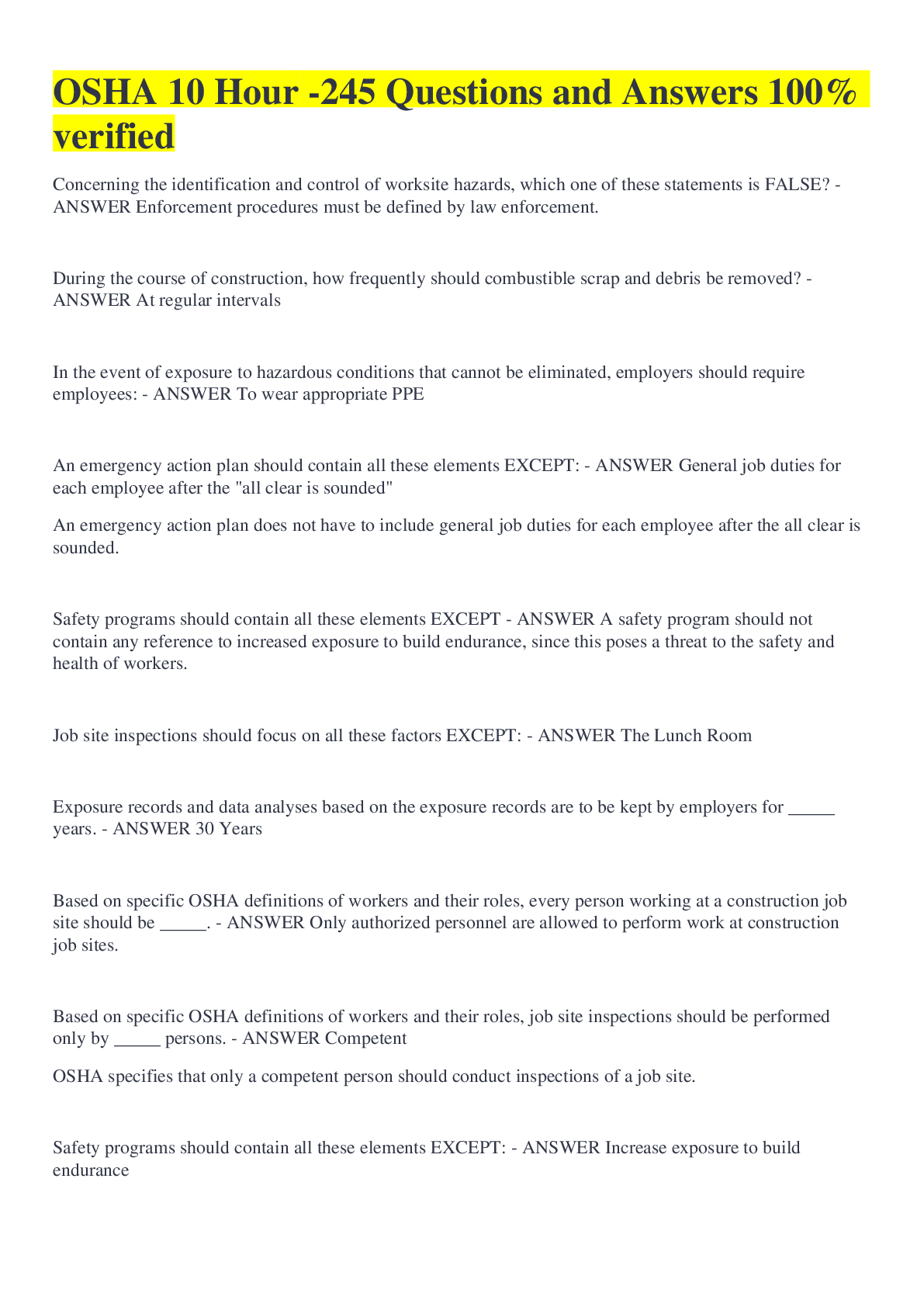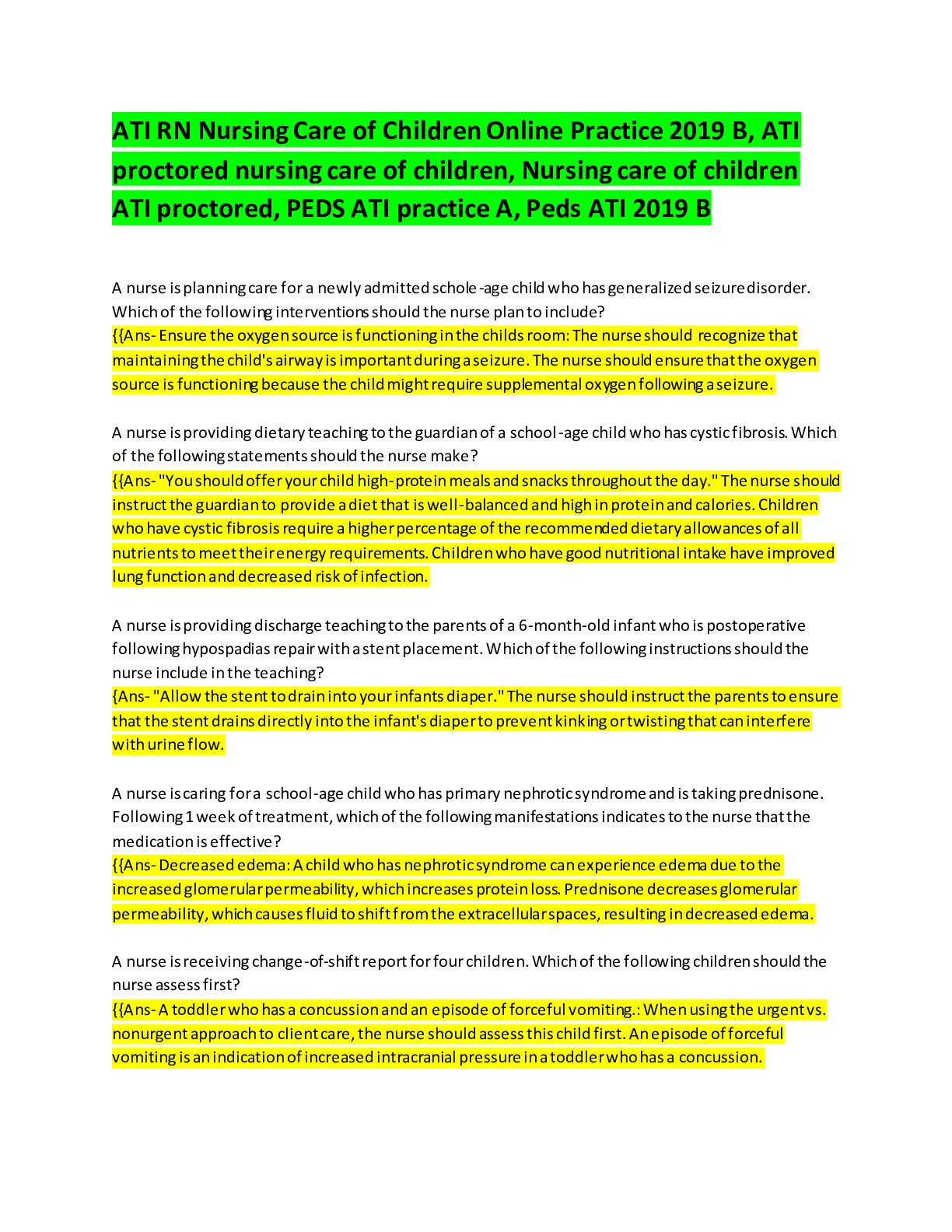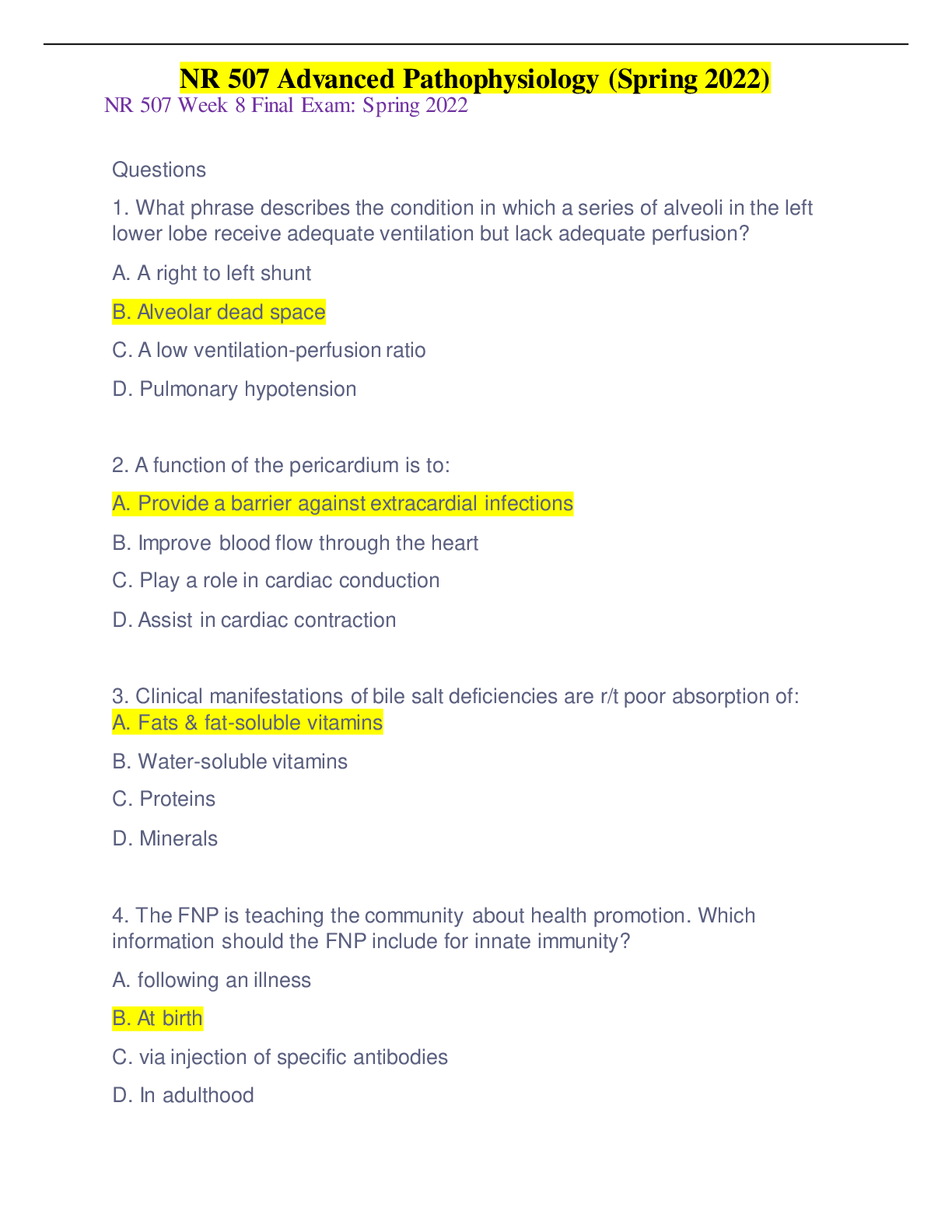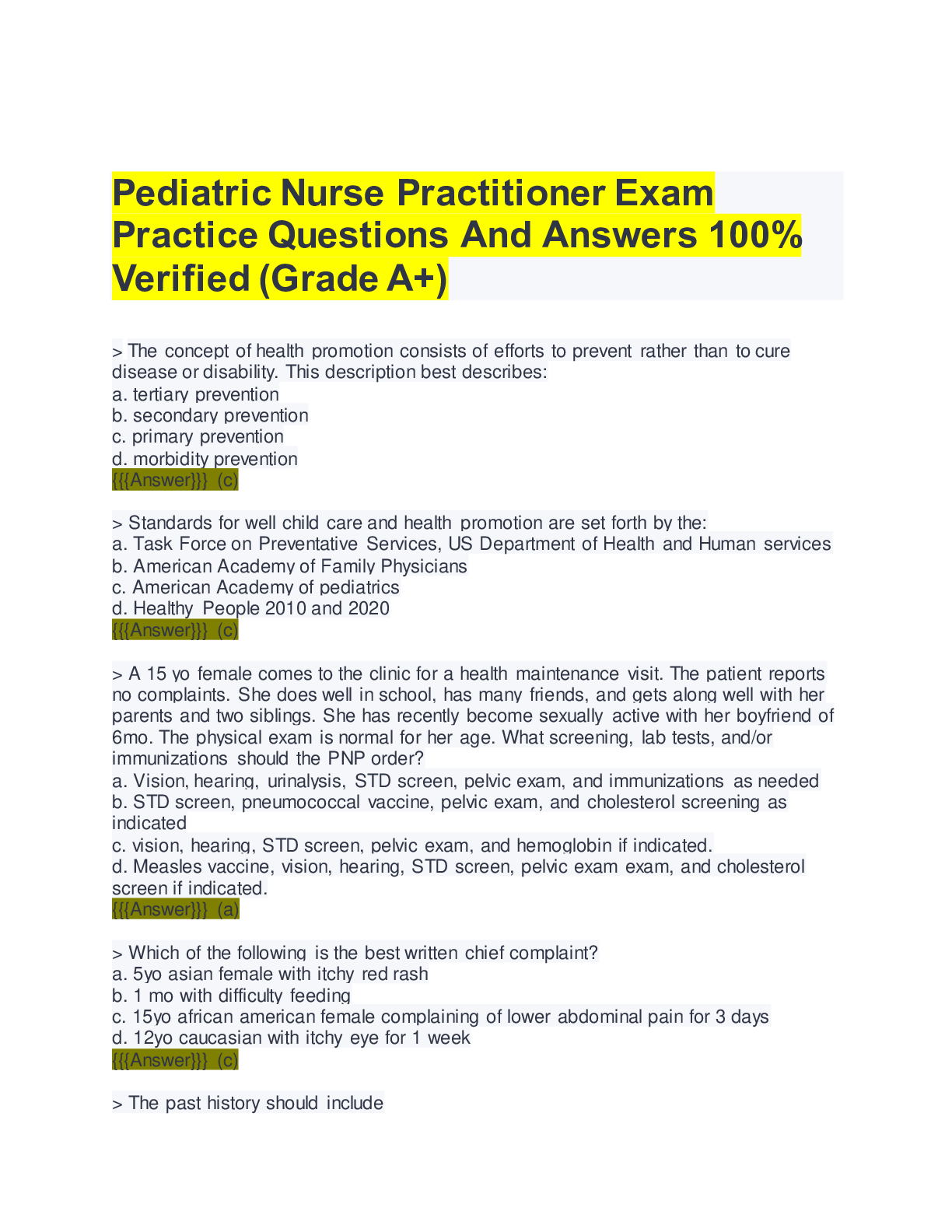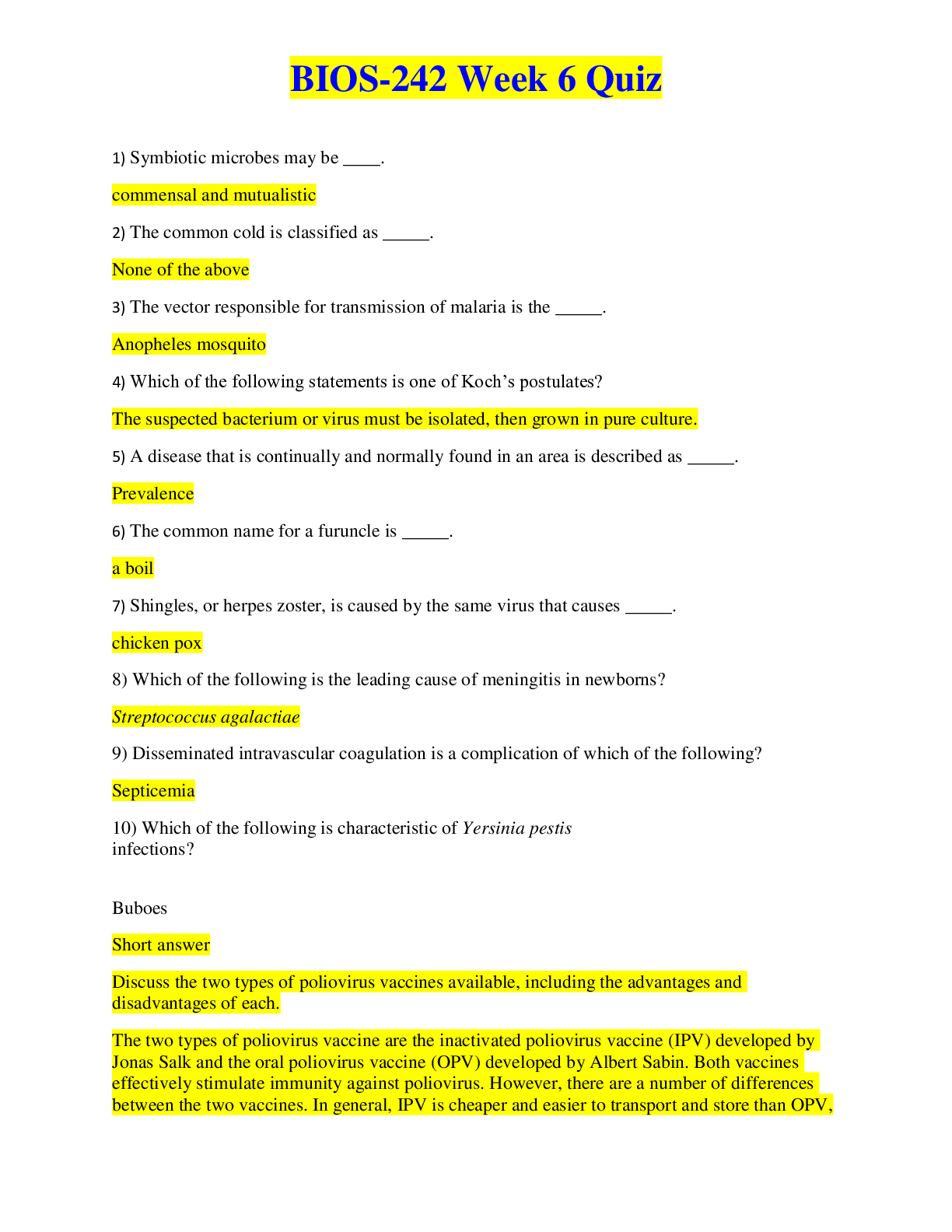*NURSING > EXAM > AGNP BOARD EXAM QUESTIONS Urology Assessment (44 Questions) with well explained answers 100% verifie (All)
AGNP BOARD EXAM QUESTIONS Urology Assessment (44 Questions) with well explained answers 100% verified for A+ solution
Document Content and Description Below
AGNP BOARD EXAM QUESTIONS Urology Assessment ( 44 Questions) Question: In renal adaptation of the newborn, which one of the following statements is correct? The kidneys have an inability to conce... ntrate urine and adapt to fluid and electrolyte stress. Correct In the nephrons of the kidneys long tubules enhance the effectiveness of tubular reabsorption. The kidneys are fully capable of concentrating urine and maintaining fluid and electrolyte balance. The kidneys have the ability to increase the production of antidiuretic hormone (ADH) effectively. Explanation: In the neonate the kidneys are structurally complete but physiologically immature. The glomeruli have an inability to filter and concentrate urine, therefore glucose and amino acids escape and there is decreased ability to remove uric acid crystals which give the reddish appearance to the urine. There is an inability to adapt to fluid and electrolyte stress leading to loss of bicarbonate and poor reabsorption. This puts the neonate at increased risk of metabolic acidosis. The tubules are short/narrow which causes a problem with reabsorption. The nephrons function well within a month. ADH inhibits diuresis and the immature kidney causes an increased risk for dehydration. Question: What is the most common non-skin cancer in America? Uterine cancer Bladder cancer Cervical cancer Prostate cancer Correct Explanation: Prostate cancer is the most common non-skin cancer in America; 1 in 8 men will be diagnosed with it at some point in their lives. In fact, nearly 60% of all prostate cancers are diagnosed in men older than 65. Question: Patients with prior hypospadias surgery who develop slow and painful urination as well as prostatitis are experiencing symptoms of: neurogenic bladder. urethral stricture. Correct benign prostatic hyperplasia (BPH). prostate cancer. Explanation: A urethral stricture may occur in patients who have undergone hypospadias surgery and experience voiding symptoms such as urinary retention and straining to void. Neurogenic bladder symptoms include urinary retention and/or incontinence associated with other underlying chronic neurologic conditions (e.g., multiple sclerosis) or after spinal cord injury. Patients with BPH experience an increase in daytime frequency, nocturia, urinary incontinence, and terminal dribbling. Prostate cancer is usually asymptomatic but can sometimes present with storage, voiding, or irritative symptoms. Question: What is the average urine pH level? 4.5 6 Correct 7 8 Explanation: The average urine pH level is 5-6, acid pH is 4.5-5.5, and alkaline pH is 6.5-8. Question: Symptoms of proctitis may include all of the following except: left-sided abdominal pain. rectal pain. suprapubic pain. Correct tenesmus. Explanation: Proctitis is inflammation of the lining of the rectum leading to rectal pain, bleeding, and a continuous sensation to defecate (tenesmus). Additional symptoms may also include left-sided abdominal pain, diarrhea, pain with bowel movements, and a feeling of fullness in the rectum. Suprapubic pain is not generally associated with proctitis. Question: A useful mnemonic for elucidating causes of incontinence in the older adult is: STOOL. DIAPERS. Correct DRIP. URINE. Explanation: For elucidating causes of incontinence, two mnemonics may be helpful: DIAPERS, (Delirium, Infection, Atrophic urethritis/vaginitis, Pharmaceuticals, Excess urine output from conditions like hyperglycemia or heart failure, Restricted mobility, and Stool impaction) and DDRRIIPP (Delirium, Drug side effects, Retention of feces, Restricted mobility, Infection of urine, Inflammation, Polyuria, and Psychogenic). Question: Which of the following symptoms is NOT associated with nephrotic syndrome? Proteinuria Hyperlipidemia Lower leg edema Hyperalbuminosa Correct Explanation: Nephrotic syndrome is diagnosed by the presence of proteinuria, hyperlipidemia, edema, or swelling (usually in the legs, feet, or ankles and less often in the hands or face), and hypoalbuminemia. Question: In afebrile patients who experience intermittent sharp flank pain in addition to gross hematuria, further testing would be indicated for: pelvic inflammatory disease (PID). pyelonephritis. nephrolithiasis. Correct urethritis. Explanation: The majority of patients with symptomatic nephrolithiasis have intermittent flank pain/renal colic in addition to gross or microscopic hematuria. In the absence of infection, fever is unusual in patients with nephrolithiasis. Abdominal or pelvic pain and fever are the most common clinical findings in patients with pelvic inflammatory disease (PID), although dysuria may also be present. Pyelonephritis often presents with flank pain, fever, and pyuria. Symptoms of urethritis include dysuria, pyuria, or burning with urination. Flank pain or hematuria is not present in urethritis. Question: After running a 5K race, a 35-year-old man presents with complaints of muscle pain in the shoulders, weakness in both legs, and dark brown urine. These findings are consistent with: a urinary tract infection (UTI). rhabdomyolysis. Correct acute renal failure. renal calculi. Explanation: Rhabdomyolysis is a serious syndrome resulting from a direct or indirect muscle injury. It results from death of muscle fibers and release of their contents into the bloodstream, leading to renal failure. Exertional activity such as running a marathon or participating in strenuous exercises can cause rhabdomyolysis. Creatinine kinase (CK) is the most reliable and sensitive marker to indicate rhabdomyolysis or severe muscle breakdown. Question: When testing for pyelonephritis, the exam technique of percussing the back over the kidney that produces flank pain is called: Murphy's sign. psoas sign. Pasternacki's sign. Correct Rovsing’s sign. Explanation: Costovertebral angle tenderness (CVA), also known as Pasternacki's sign (Murphy's punch or Goldflam's sign), is a medical test in which findings of pain are elicited by percussion of the back over either kidney when infection is present. Murphy's sign assesses for cholecystitis. Murphy's sign is positive if hypersensitivity to deep palpation in the subcostal area occurs when a patient with gallbladder disease takes a deep breath. Psoas sign indicates irritation to the iliopsoas group of hip flexors in the abdomen, and consequently indicates that the inflamed appendix is retrocecal in orientation. Rovsing's sign indicates peritoneal irritation. If palpation of the left lower quadrant of a person's abdomen increases the pain felt in the right lower quadrant, the patient is said to have a positive Rovsing's sign and may have appendicitis. Question: A form of urinary incontinence that is characterized by the involuntary release of urine from a full bladder in the absence of any need to urinate is called: stress incontinence. urge incontinence. overflow incontinence. Correct functional incontinence. Explanation: Overflow incontinence is a form of urinary incontinence that is characterized by the involuntary release of urine from a full bladder in the absence of any need to urinate. This condition occurs in people who have a blockage of the bladder outlet (benign prostatic hyperplasia, prostate cancer, or narrowing of the urethra), or when the muscle that expels urine from the bladder is too weak to empty the bladder normally. Stress incontinence, also known as effort incontinence, is due essentially to insufficient strength of the pelvic floor muscles to prevent the passage of urine, especially during activities that increase intra-abdominal pressure, such as coughing, sneezing, or bearing down. Urge incontinence is involuntary loss of urine occurring for no apparent reason while suddenly feeling the need or urge to urinate. Functional incontinence is a form of urinary incontinence in which a person is usually aware of the need to urinate, but for one or more physical or mental reasons is unable to hold urine. Question: One cause of proctitis could be related to: gastritis. frequent anal intercourse. Correct cirrhosis. pancreatitis. Explanation: Proctitis is inflammation of the lining of the rectum leading to rectal pain, bleeding, and a continuous sensation to defecate. Causes may include: inflammatory bowel disease, sexually transmitted infections, radiation therapy, and frequent anal intercourse. Question: An infection or irritation of the bladder that leads to pain on urination is called: polyuria. dysuria. Correct urgency. incontinence. Explanation: An infection or irritation of the bladder that leads to pain on urination is called dysuria. Polyuria is a production of abnormally large volumes of dilute urine. Urinary urgency is a sudden, compelling urge to urinate. Urinary frequency or incontinence is the need to urinate more often than usual. Question: Symptoms of fever, chills, flank pain, costovertebral angle tenderness (CVA), and vomiting suggest: pelvic inflammatory disease (PID). pyelonephritis. Correct nephrolithiasis. urethritis. Explanation: Symptoms of pyelonephritis include flank pain, fever, costovertebral angle tenderness (CVA), and vomiting. Pelvic pain and fever are the most common clinical findings in patients with pelvic inflammatory disease (PID), however, CVA tenderness is not found. The majority of patients with symptomatic nephrolithiasis have flank pain/renal colic in addition to gross or microscopic hematuria. In the absence of infection, fever is unusual in patients with nephrolithiasis. Symptoms of urethritis include dysuria, particularly those with pyuria on urinalysis, but rarely causes fever or CVA tenderness. Question: Which of the following substances is found in the urine of a child suspected of having post streptococcal glomerulonephritis? Blood and protein Correct Bacteria and ketones Glucose and white blood cells Casts and mucous threads Explanation: With post streptococcal (strep) glomerulonephritis, a child may have a history of a recent strep infection (pharyngitis or impetigo). Proteinuria is secondary to altered glomerular structure and functioning. Gross hematuria causes the urine to be tea- colored. Bacteria, white blood cells and mucus can be seen with urinary tract infections. Glucose and ketones present in the urine may be associated with diabetes. Question: A significant increase in 24-hour urine volume that exceeds 3 liters is called: polyuria. Correct dysuria. urgency. frequency. Explanation: Polyuria refers to a significant increase in 24-hour urine volume that exceeds 3 liters. Question: The findings of mucopurulent endocervical discharge and cervical motion tenderness on pelvic examination are strongly suggestive of: pelvic inflammatory disease (PID). Correct pyelonephritis. nephrolithiasis urethritis. Explanation: Abdominal or pelvic pain and fever are the most common clinical findings in patients with pelvic inflammatory disease (PID), although dysuria may also be present. The findings of mucopurulent endocervical discharge or cervical motion tenderness on pelvic examination are strongly suggestive of PID. Cervical motion tenderness and endocervical discharge are not found with pyelonephritis, nephrolithiasis, or urethritis. Question: In men, painful urination without frequency or urgency suggests: cystitis. urethritis. Correct constipation. acute prostatitis. Explanation: In men, painful urination without frequency or urgency suggests urethritis. Cystitis presents with frequency and urgency. Constipation usually does not present with urinary tract symptoms. Acute prostatitis presents with frequency, urgency, and dysuria. Question: Which one of the following is NOT a cause of vaginitis? yeast infection. herpes simplex virus. Correct trichomoniasis. bacterial vaginosis (BV). Explanation: Approximately 90% of all cases of vaginitis are thought to be attributed to three causes: bacterial vaginosis, vaginal candidiasis (or vulvovaginal candidiasis), and trichomonas vaginalis infection (trichomoniasis). Herpes simplex virus does not cause vaginitis. Question: Which one of the following conditions is NOT related to polyuria? lithium toxicity. hyperkalemic nephropathy. Correct uncontrolled diabetes. hypogonadism. Explanation: Kidney diseases such as hypokalemic nephropathy, lithium toxicity, uncontrolled diabetes, and disorders of the posterior pituitary and hypothalamus (ex. Hypogonadism) cause polyuria. Question: The prostate is assessed by: a digital rectal examination (DRE). Correct a formal urinalysis. testicular palpation and cough. palpation of the left lower quadrant. Explanation: A digital rectal exam (DRE) is performed to assess prostate size and consistency. A urinalysis is not indicated in the primary assessment of the prostate. Inguinal hernia assessment involves feeling for a bulge or impulse while the patient coughs or strains. Rovsing's sign (right lower quadrant pain with palpation of the left lower quadrant) suggests peritoneal irritation. Question: Which one of the following patient positions would be least beneficial to examine the genitals of a young female child? Have the child sit on her parent's lap with the parent holding the child's knees apart Have the child lie supine in the frog-leg position Have the child sit crossed legged on the examination table Correct Position the child in the knee-chest position Explanation: To properly visualize the genitals of a young female child, she can be positioned on the parent's lap with the knees apart, supine in a frog-leg position, or in the knee-chest position. Having her sit crossed-legged would not expose the genitals. This position is useful when examining the male child and eliciting the cremasteric reflex. Question: Benign prostatic hypertrophy begins in the: second decade of life. third decade of life. Correct fourth decade of life. fifth decade of life. Explanation: In men, proliferation of prostate epithelial and stromal tissue, termed benign prostatic hyperplasia (BPH), begins in the third decade, and symptoms occur in only about half of men with enlargement. Hyperplasia continues to increase prostate volume until the seventh decade, then appears to plateau. These changes are androgen dependent. Question: Patients with multiple sclerosis (MS) who develop urinary incontinence are further evaluated for: neurogenic bladder. Correct urethral stricture. benign prostatic hyperplasia (BPH). prostatitis. Explanation: Neurogenic bladder symptoms include urinary retention and/or incontinence associated with other underlying chronic neurologic conditions (e.g., multiple sclerosis) or after spinal cord injury. A urethral stricture causes symptoms of urinary hesitancy found with the presence of scar tissue after hypospadias surgery. Prostatitis is a bacterial infection caused by untreated sexually transmitted diseases (STD), urinary tract infection (UTI), or enlarged prostate. Question: Which condition usually coexists with epididymitis? Varicocele of the spermatic cord Spermatocele of the epididymis Torsion of the spermatic cord Chlamydia infection Correct Explanation: An acutely inflamed epididymis is tender and swollen and may be difficult to distinguish from the testicle. Additionally, the scrotum may be reddened and the vas deferens inflamed. It occurs most commonly in adults who are affected with Chlamydia. Coexisting urinary tract infection or prostatitis supports the diagnosis. Varicocele refers to varicose veins of the spermatic cord, usually found on the left. It feels like a soft “bag of worms" on palpation of the scrotum. A painless, movable cystic mass just above the testicle suggests a spermatocele or an epididymal cyst. Both transilluminate. Torsion, or twisting, of the testicle on its spermatic cord produces an acutely painful, tender, and swollen organ that is retracted upward in the scrotum. The scrotum becomes red and edematous. There is no associated urinary infection in a patient who has testicular torsion. Question: A 50-year-old male describes difficulty emptying his bladder. On exam, a distended bladder is noted following urination. This finding may be associated with: functional incontinence. overflow incontinence. Correct urge incontinence. stress incontinence. Explanation: Overflow incontinence is associated with a neurological or anatomical obstruction from pelvic organs or the prostate which limits bladder emptying and causes a distended bladder. Stress incontinence is commonly seen in women and arises from decreased intraurethral pressure. This condition is noted when a patient coughs, sneezes, or laughs. In urge incontinence, urgency is followed by immediate involuntary leakage due to uncontrolled detrusor contractions that overcome urethral resistance. Following an urge to void, there is an involuntary loss of urine. Functional incontinence usually arises from cognitive impairment, musculoskeletal problems, or immobility. Question: Clinical manifestations of dysuria, frequency, urgency, suprapubic pain, and hematuria in a woman suggest: cystitis. Correct vaginitis. urethritis. nephrolithiasis. Explanation: Clinical manifestations of cystitis in women consist of dysuria, frequency, urgency, suprapubic pain, and/or hematuria. Symptoms of vaginitis include dysuria, the presence of vaginal discharge or odor, pruritus, dyspareunia, and absence of urinary frequency or urgency. Evaluation for urethritis is warranted in sexually active women with dysuria, particularly those with pyuria on urinalysis but no bacteriuria. Patients with symptomatic nephrolithiasis have flank pain/renal colic in addition to gross or microscopic hematuria. Question: Which one of the following symptoms would be least indicative of acute glomerulonephritis? Hematuria Polyuria Correct Proteinuria Hypertension Explanation: Symptoms of acute glomerulonephritis include hematuria. This is a universal finding, even if it is microscopic. Gross hematuria is reported in 30% of pediatric patients, often manifesting as smoky, coffee, or cola-colored urine. Oliguria is seem. Hypertension proteinuria edema (peripheral or periorbital) is reported in approximately 85% of pediatric patients. Edema may be mild (involving only the face) to severe, bordering on a nephrotic appearance. Headache may occur secondary to hypertension. Confusion may occur secondary to malignant hypertension in as many as 5% of patients. Shortness of breath or dyspnea on exertion may occur secondary to heart failure or pulmonary edema. It is usually uncommon, particularly in children. Possible flank pain secondary to stretching of the renal capsule may occur. Question: A 65-year-old woman complains that when she feels the urge to urinate, she has to go immediately or else she urinates "on herself". She has become homebound because she wants to stay close to the bathroom. This condition is termed: functional incontinence. overflow incontinence. urge incontinence. Correct stress incontinence. Explanation: In urge incontinence, (overactive bladder), urgency is followed by immediate involuntary leakage due to uncontrolled detrusor contractions that overcome urethral resistance. Following an urge to void, there is an involuntary loss of urine since the patient cannot get to the toilet quickly enough. Overflow incontinence is associated with a neurological or anatomical obstruction from pelvic organs or the prostate which limits bladder emptying and causes an overdistended bladder. Stress incontinence is commonly seen in women and arises from decreased intraurethral pressure. This condition is generally noted when a patient coughs, sneezes, or laughs. Functional incontinence usually arises from cognitive impairment, musculoskeletal problems, or immobility. Question: Insufficient strength of the pelvic floor muscles that results in incontinence during activities such as coughing, sneezing, or bearing down, is called: urge incontinence. stress incontinence. Correct overflow incontinence. functional incontinence. Explanation: Stress incontinence, also known as effort incontinence, is due to insufficient strength of the pelvic floor muscles to prevent the passage of urine, especially during activities that increase intra-abdominal pressure, such as coughing, sneezing, or bearing down. Urge incontinence is involuntary loss of urine occurring for no apparent reason while suddenly feeling the need or urge to urinate. Overflow incontinence is characterized by the involuntary release of urine, often in the absence of any urge to urinate. Functional incontinence is a form of urinary incontinence in which a person is usually aware of the need to urinate, but for one or more physical or mental reasons cannot hold urine. Question: A 40 -year-old male states that he felt "something" above his left testis. On examination, a painless cyst is noted above the left testicle. Transillumination is positive. This is consistent with a: varicocele of the spermatic cord. spermatocele of the epididymis. Correct torsion of the spermatic cord. prostatitis. Explanation: A painless, movable cystic mass just above the testicle suggests a spermatocele or an epididymal cyst. Both transilluminate and are difficult to distinguish clinically. An acutely inflamed epididymis is tender and swollen and may be difficult to distinguish from the testicle. Additionally, the scrotum may be reddened and the vas deferens inflamed. Coexisting urinary tract infection, or prostatitis, supports the diagnosis. Varicocele refers to varicose veins of the spermatic cord, usually found on the left. It feels like a soft “bag of worms" upon palpation of the scrotum. Torsion, or twisting, of the testicle on its spermatic cord produces an acutely painful, tender, and swollen organ that is retracted upward in the scrotum. The scrotum becomes red and edematous. There is no associated urinary infection. Question: When screening for bladder cancer in a primary care setting, the test that would be LEAST appropriate is: microscopic urinalysis. urine cytology. cystoscopy. Correct dipstick for hematuria. Explanation: Screening tests feasible for use in primary care when screening for bladder cancer include: urine dipstick or microscopic urinalysis for hematuria, urine cytology, and tests for urine biomarkers. Patients with positive screening results are referred to a urologist for further evaluation, which includes cystoscopy (and biopsy if a tumor is found), imaging, and other studies. Question: When examining the scrotum in a young male child, test the cremasteric reflex by: scratching the medial aspect of the thigh. Correct having the child lie down and palpate the femoral pulse. gently pulling the penis downward. palpating the area above the symphysis pubis. Explanation: To elicit the cremasteric reflex, examine the child when he is relaxed and have him sit crossed legged on the table. Palpate the scrotum. The child can also blow into a balloon, this would cause an increase in intra-abdominal pressure and stimulate the reflex. The cremasteric reflex can be tested by scratching the inside of the child's thigh. Pulling the penis downward, palpating the femoral pulse or the area above the symphysis pubis do not elicit this reflex. Question: Findings of myoglobin in the urine specimen suggest: renal colic. nephrolithiasis. pyelonephritis. rhabdomyolysis. Correct Explanation: Myoglobinuria occurs in the presence of rhabdomyolysis or muscle destruction. Myoglobin is present in muscle cells as a reserve of oxygen. Trauma, vascular problems, malignant hyperthermia, certain drugs and other situations can destroy or damage the muscle, releasing myoglobin to the circulation and thus to the kidneys. The release of myoglobin from muscle cells is often associated with an increase in levels of creatine kinase (CK), aldolase, lactate dehydrogenase (LDH), serum glutamic-pyruvic transaminase (SGPT), and other enzymes. If too much myoglobin is released into the circulation, it can occlude the renal filtration system, leading to acute tubular necrosis and acute renal insufficiency. Myoglobin is not found in the urine of patients with renal colic, nephrolithiasis, or pyelonephritis. Question: Which of the following is described as an involuntary loss of urine occurring for no apparent reason while suddenly feeling the need to urinate? Stress incontinence Urge incontinence Correct Overflow incontinence Functional incontinence Explanation: Urge incontinence is involuntary loss of urine occurring for no apparent reason while suddenly feeling the need or urge to urinate. Stress incontinence is due essentially to insufficient strength of the pelvic floor muscles to prevent the passage of urine, especially during activities that increase intra-abdominal pressure. Overflow incontinence is a form of urinary incontinence that is characterized by the involuntary release of urine from a full bladder in the absence of any need to urinate. Functional incontinence is a form of urinary incontinence in which a person is usually aware of the need to urinate, but for physical or mental reasons is unable to hold urine. Question: A gynecological infection characterized by itching, burning, and a vaginal discharge that is typically cheesy in texture and white in color is: trichomoniasis. bacterial vaginosis (BV). yeast infection. Correct gonorrhea. Explanation: A vaginal yeast infection is characterized by itching, burning, soreness, pain during intercourse and/or urination, and vaginal discharge that is typically cheesy in texture and white in color. Trichomoniasis, bacterial vaginosis, and gonorrhea do not have symptoms of vaginal itching or classic presentation of a cheesy white discharge. Question: A 40 year old male complains of right flank pain. His temperature is 102° F. These symptoms may be characteristic of: renal calculi. acute pyelonephritis. Correct urethritis. prostatitis. Explanation: Kidney pain in the flank area and groin that is accompanied by fever and chills is consistent with acute pyelonephritis. Renal or ureteral colic usually presents with a sudden onset of pain in the flank area, abdomen, or groin. Chills and fever do not generally accompany urinary calculi. In men, painful urination without frequency or urgency suggests urethritis. Acute prostatitis presents with frequency, urgency, and dysuria. Question: Chronic bladder pain syndrome (BPS) that causes symptoms of urinary urgency, frequency, and hesitancy is also known as: interstitial cystitis. Correct endometriosis. urinary tract infection. pelvic inflammatory disease. Explanation: Interstitial cystitis (IC), also known as bladder pain syndrome (BPS), is characterized by chronic bladder pain. Symptoms include feeling the need to urinate right away, needing to urinate often, and urinary hesitancy. Endometriosis is a painful disorder in which the endometrium grows outside the uterus. Common urinary tract infection (UTI) symptoms include a frequent urge to urinate and pain or burning when urinating. Pelvic inflammatory disease symptoms include abdominal pain, vaginal discharge, abnormal uterine bleeding, and painful urination. Question: A 66-year-old man presents with complaints of recent nocturia, hesitancy, straining, and a slow urine stream. These symptoms describe: neurogenic bladder. urethral stricture. benign prostatic hyperplasia (BPH). Correct prostate cancer. Explanation: Patients with benign prostatic hyperplasia (BPH) experience an increase in daytime frequency, nocturia, urgency, urinary incontinence, slow urinary stream, splitting or spraying of the urinary stream, intermittent urinary stream, hesitancy, straining to void, and terminal dribbling. Urethral stricture often presents with voiding symptoms, such as slow urinary stream or straining to void. Neurogenic bladder presents with urinary retention and/or incontinence associated with other underlying chronic neurologic conditions (e.g., multiple sclerosis) or after spinal cord injury. Prostate cancer is usually asymptomatic but can sometimes present with storage, voiding, or irritative symptoms. Question: Undescended testicle(s) in a young male is termed: testicular torsion. epispadias. hydrocele. cryptorchidism. Correct Explanation: The term cryptorchidism is used to denote undescended testicles. Epispadias is present when the urethral orifice is located on the dorsal surface of the glans or shaft of the penis. A hydrocele denotes fluid in the scrotal sac. Testicular torsion occurs when the spermatic cord (from which the testicle is suspended) twists, reducing the testicle's blood supply resulting in ischemia of that testicle. This is a medical emergency. Question: A form of urinary incontinence in which a person is usually aware of the need to urinate, but for one or more physical or mental reasons they are unable to get to a bathroom, is referred to as: stress incontinence. urge incontinence. overflow incontinence. functional incontinence. Correct Explanation: Functional incontinence is a form of urinary incontinence in which a person is usually aware of the need to urinate, but for one or more physical or mental reasons is unable to get to a bathroom. Stress incontinence, also known as effort incontinence, is due to insufficient strength of the pelvic floor muscles to prevent the passage of urine, especially during activities that increase intra-abdominal pressure, such as coughing, sneezing, or bearing down. Urge incontinence is involuntary loss of urine occurring for no apparent reason while suddenly feeling the need or urge to urinate. Overflow incontinence is a form of urinary incontinence that is characterized by the involuntary release of urine from a full bladder in the absence of any need to urinate. Question: A whitish sebaceous secretion that collects between the glans penis and foreskin or in the vulva is known as: candida. smegma. Correct leukorrhea. leukocoria. Explanation: A whitish sebaceous secretion that collects between the glans penis and foreskin or in the vulva is known as smegma. Candida can occur as a result of a yeast infection and in the vaginal area. It appears as a white substance usually causing vaginal itching. Leukorrhea refers to a thick whitish or yellowish vaginal discharge commonly seen during pregnancy. Leukocoria is an abnormal white reflection from the retina of the eye and its presence could indicate retinoblastoma or a congenital cataract. Question: A 33 year old male presents for examination because of a scrotal complaint. The exam reveals the presence of 2 testicles and palpable tissue resembling a "bag of worms" over the left testicle. When in the supine position with the scrotum elevated, the "bag of worms" disappears. This condition is suggestive of a: varicocele of the spermatic cord. Correct spermatocele of the epididymis. torsion of the spermatic cord. prostatitis. Explanation: Varicocele refers to varicose veins of the spermatic cord, usually found on the left. It feels like a soft “bag of worms" upon palpation of the scrotum. An acutely inflamed epididymis is tender and swollen and may be difficult to distinguish from the testicle. The scrotum may be reddened and the vas deferens inflamed. Epididymitis occurs usually in adults, who are infected with Chlamydia. Coexisting urinary tract infection or prostatitis support the diagnosis. A painless, movable cystic mass just above the testicle suggests a spermatocele or an epididymal cyst. Both transilluminate. Torsion, or twisting, of the testicle on its spermatic cord produces an acutely painful, tender, and swollen organ that is retracted upward in the scrotum. The scrotum becomes red and edematous. There is no associated urinary infection. Question: Glomerulonephritis can cause: nephrotic syndrome. Correct diabetic nephropathy. polycystic kidney disease. pyelonephritis. Explanation: Glomerulonephritis can lead to nephrotic syndrome, which is the loss of a large amount of protein in the urine that leads to sodium and fluid retention in the body. Complications of nephrotic syndrome include hypertension, hyperlipidemia, and peripheral edema. [Show More]
Last updated: 1 year ago
Preview 1 out of 15 pages
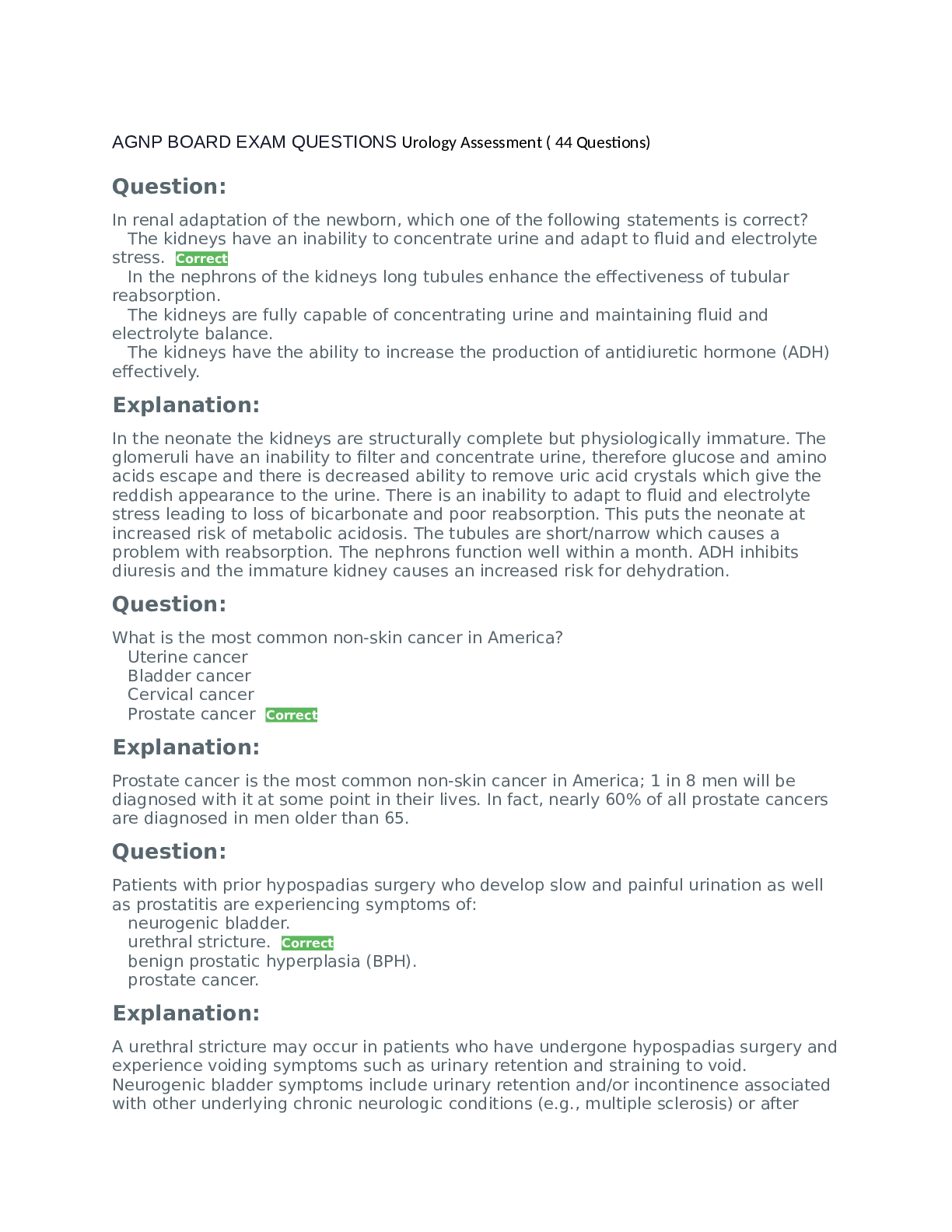
Reviews( 0 )
Document information
Connected school, study & course
About the document
Uploaded On
May 15, 2021
Number of pages
15
Written in
Additional information
This document has been written for:
Uploaded
May 15, 2021
Downloads
0
Views
68
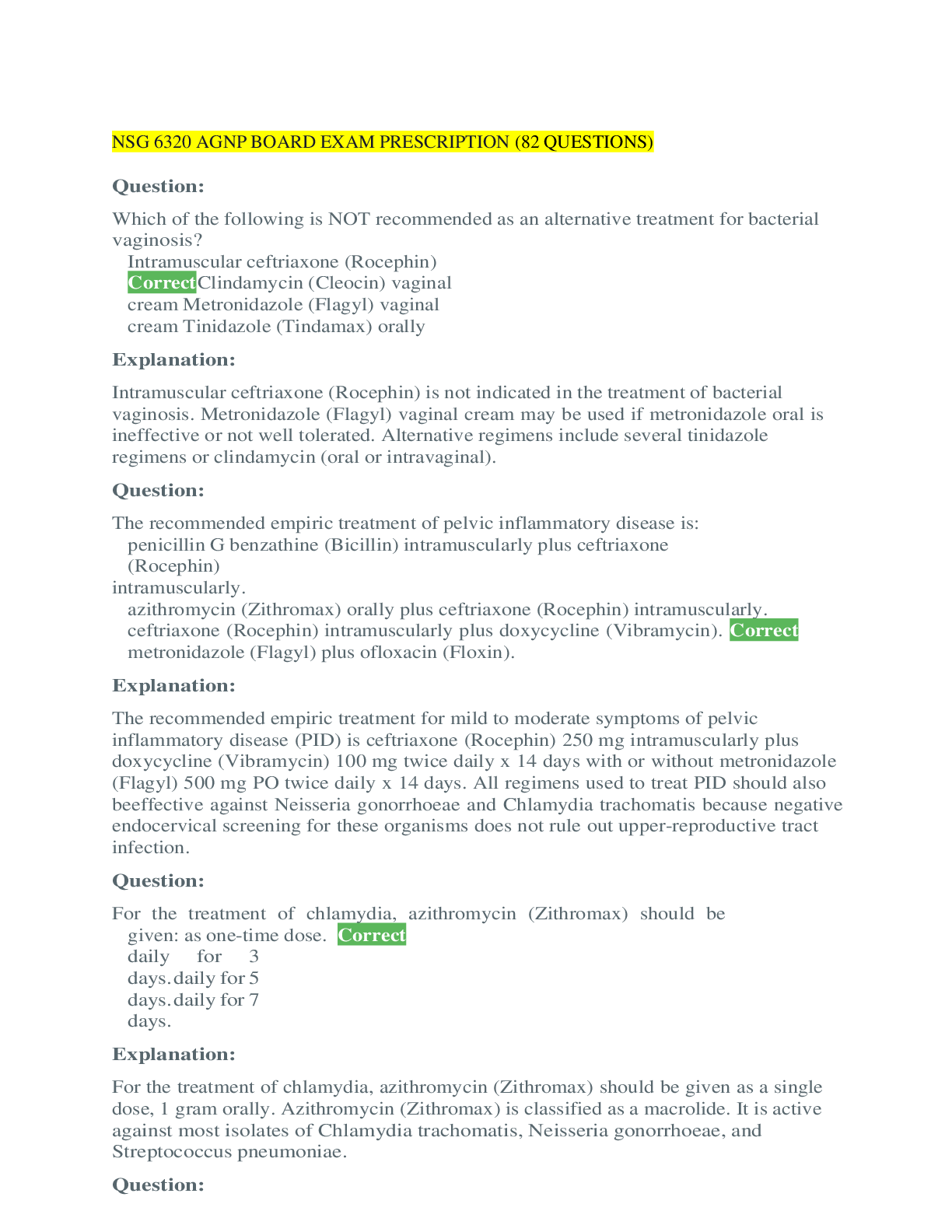






.png)










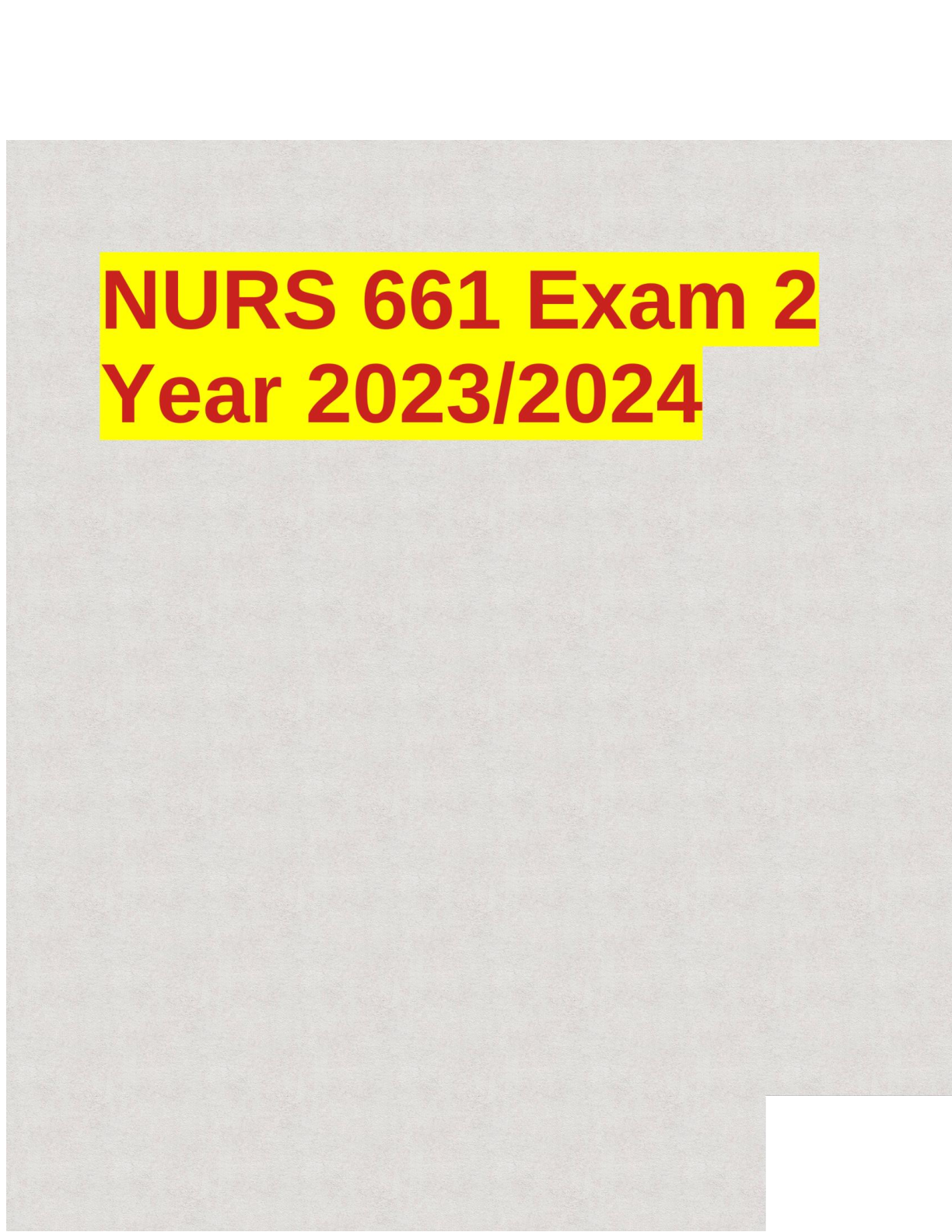


.png)
